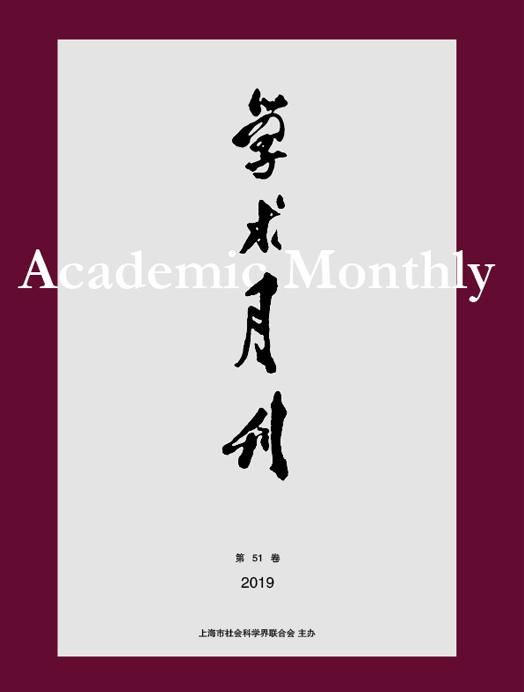Citation:
Zhengxu WANG. Order and Prosperity: An Institutionalist Framework for First Questions of Politics[J]. Academic Monthly, 2022, 54(3): 110-123.

Order and Prosperity: An Institutionalist Framework for First Questions of Politics
-
Abstract
Political order is the essential goal for all political activities. Eliminating wars, violence, hunger and robbery, among others, a basic political order is achieved. On the basis of it, political community would pursue an order that is defined by prosperity. This paper first discuss the concept of political order, and provides an institutionalist conceptual framework for the understanding the forming of political order. Institutions that make political order possible operates at four levels, i.e. value, cogitation, organization, and technique. I then show how the political order of China, generally referred to as socialism with Chinese characteristics, is formed on these four institutional levels, as well as comparing this order to the US order that is called a capitalist liberal democratic order. This framework or theory of political order should help the field move beyond the narrowly focused dichotomy of democracy vs. autocracy.
-

-
References
-
Access
-
-
[1]
OU Shujun
. . Academic Monthly,
2018, 50(9): 92-100.
-
[2]
Pei ZHAO
. Further Investigation on the Authority of Confucian Classics from the Perspective of Classicization. Academic Monthly,
2021, 53(2): 36-49.
-
[3]
Shikai WANG
. Organic Unified Politics:The Core of Chinese Socialist System’s Stereotype. Academic Monthly,
2020, 52(2): 76-85, 94.
-
[4]
MENG Jie
. From the Theory of State Distribution to the Theory of Socialist Public Finance with Chinese Characteristics—— A Political Economy Study on the Construction of Independent Knowledge System of China’s Financial Basic Theory. Academic Monthly,
2023, 55(12): 25-40.
-
[5]
Jitong LIU
. The Social Construction of “Social Welfare Consensus” in China and the Goal of Modern Socialist Welfare State. Academic Monthly,
2022, 54(6): 73-84.
-
[6]
Yao CHEN
, Tiantian CHEN
. How Systems Produce Governance Effciency: 70-Years Experience in China’s National Governance. Academic Monthly,
2020, 52(2): 86-94.
-
[7]
Zhouwang CHEN
. All-dimensions Democracy: The Theories and Institutional Choice of the Socialist Democracy with Chinese Characteristics. Academic Monthly,
2020, 52(2): 68-75.
-
[8]
Shikai WANG
. Political System Capacity: An Analytical Framework to Explain the Rise and Fall of National Governance. Academic Monthly,
2021, 53(10): 88-101.
-
[9]
Zhenhua HUANG
. Household Logic of National Governance: An Analytical Approach Based on Field Politics. Academic Monthly,
2021, 53(7): 91-104, 178.
-
[10]
Wei LIU
. The Doctrinal System and Theoretical Logic of Xi Jinping’s “Socialist Political Economy with Chinese Characteristics”. Academic Monthly,
2021, 53(5): 5-16.
-
[11]
Liang GUO
. The Order outside of the Law: “Habitual Interests” in Land and Its Governance. Academic Monthly,
2022, 54(7): 107-116.
-
[12]
Shuaiyi WANG
. Trial without Law: Land Disputes in Traditional Chinese Governance System. Academic Monthly,
2019, 51(12): 106-120.
-
[13]
Zhijun YANG
. Central Cohesive - Local Closed Policy System and Its Renewal: The Political Resource Reconstruction of National Governance Modernization. Academic Monthly,
2022, 54(1): 98-111.
-
[14]
XIONG Bingwan
. The System of Basic Legal Regimes for Data Market. Academic Monthly,
2024, 56(1): 102-114.
-
[15]
Mingjun ZHANG
. Instrumental Rationality and the Form of Liberal Political Romanticism. Academic Monthly,
2021, 53(12): 85-95.
-
[16]
Yongpeng FAN
. The Origin and Essence of American System: From Corporation to State. Academic Monthly,
2020, 52(10): 62-76.
-
[17]
Rongyu WANG
. Institutionalism of Law Revisited: The Distinction between Old and New and the Analysis of Similarities and Differences. Academic Monthly,
2020, 52(9): 110-122.
-
[18]
Chengyan ZHU
, Jian’guo CHU
. The Coordination between Central and Local Governments and the Transition of the Vertical Political System in Contemporary China. Academic Monthly,
2019, 51(4): 73-83.
-
[19]
Guoqiang YANG
. Politics of Literati-officials: Political Power and Culture of Imperial Examination System. Academic Monthly,
2021, 53(11): 200-216.
-
[20]
Daogen ZHANG
. A Political-economic Analysis of China’s Economic Institutional Innovation. Academic Monthly,
2020, 52(3): 5-14.
-
-



 沪公网安备 31010102003103号
沪公网安备 31010102003103号 DownLoad:
DownLoad: